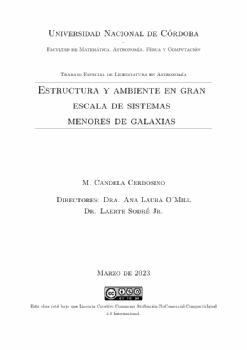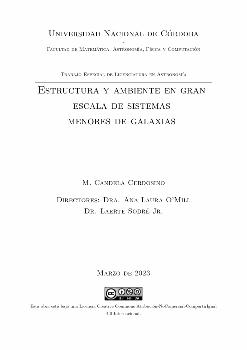| dc.contributor.advisor | O'Mill, Ana Laura | |
| dc.contributor.advisor | Sodré, Laerte | |
| dc.contributor.author | Cerdosino, María Candela | |
| dc.date.accessioned | 2023-04-04T12:50:18Z | |
| dc.date.available | 2023-04-04T12:50:18Z | |
| dc.date.issued | 2023-03 | |
| dc.identifier.uri | http://hdl.handle.net/11086/546928 | |
| dc.description | Tesis (Lic. en Astronomía)--Universidad Nacional de Córdoba, Facultad de Matemática, Astronomía, Física y Computación, 2023. | es |
| dc.description.abstract | Dentro de los grupos de galaxias se encuentran sistemas con una menor cantidad de miembros: los sistemas menores, en particular, los pares de galaxias. En este Trabajo Especial de Licenciatura se pretende aportar al conocimiento de dichos sistemas mediante un análisis fotométrico de los mismos. Para ello, se obtuvo una muestra de pares de galaxias aislados a partir de la implementación de un algoritmo de identificación por primera vez para el catálogo fotométrico de 12 filtros Southern Photometric Local Universe Survey (S-PLUS). Dicho algoritmo se probó utilizando un catálogo simulado que reproduce las propiedades físicas del S-PLUS, a partir del análisis de la completitud y pureza individual de los pares. Posteriormente, se realizó un análisis fotométrico del color de los pares. Para ello, se definió una separación entre galaxias rojas y azules y se analizaron las fracciones de galaxias rojas y de los tipos de pares en función de diferentes propiedades. Finalmente, se estudió el entorno de los sistemas mediante el análisis de la densidad local proyectada de los mismos. | es |
| dc.description.abstract | Within galaxy groups, there are systems with a smaller number of members: the minor systems, in particular, galaxy pairs. This work aims to contribute to the knowledge of these systems through a photometric analysis of them. For this purpose, a sample of isolated galaxy pairs was obtained from the implementation of an identification algorithm for the first time for the 12-filter photometric catalog of the Southern Photometric Local Universe Survey (S-PLUS). This algorithm was tested using a mock catalog that reproduces the physical properties of S-PLUS, based on the analysis of the completeness and individual purity of the pairs. Subsequently, a photometric analysis of the color of the pairs was performed. For this purpose, a separation between red and blue galaxies was defined, and the fractions of red galaxies and pair types were analyzed as a function of different properties. Finally, the environment of the systems was studied by analyzing the projected local density of the pairs. | en |
| dc.language.iso | spa | es |
| dc.rights | Atribución-NoComercial-CompartirIgual 4.0 Internacional | * |
| dc.rights.uri | http://creativecommons.org/licenses/by-nc-sa/4.0/ | * |
| dc.subject | Galaxias | es |
| dc.subject | Estudios del cielo | es |
| dc.subject | Técnicas numéricas | es |
| dc.subject | Sistemas menores | es |
| dc.subject | Pares de galaxias | es |
| dc.subject | Identificación de sistemas de galaxias | es |
| dc.subject | Color de las galaxias | es |
| dc.subject | Entorno de las galaxias | es |
| dc.subject | Catálogos fotométricos de galaxias | es |
| dc.subject | Galaxies | en |
| dc.subject | Sky surveys | en |
| dc.subject | Numerical techniques | en |
| dc.subject | Southern photometric local universe survey | en |
| dc.subject | S-PLUS | en |
| dc.title | Estructura y ambiente en gran escala de sistemas menores de galaxias | es |
| dc.type | bachelorThesis | es |
| dc.description.fil | Fil: Cerdosino, María Candela. Universidad Nacional de Córdoba. Facultad de Matemática, Astronomía, Física y Computación; Argentina. | es |






